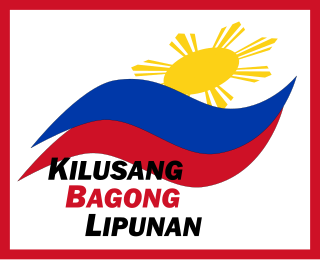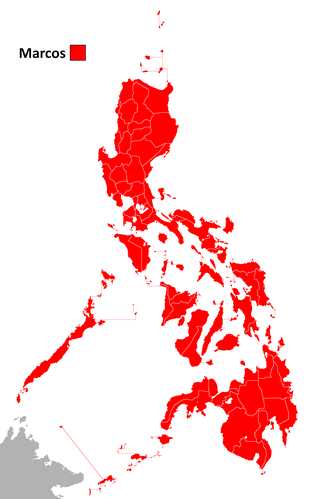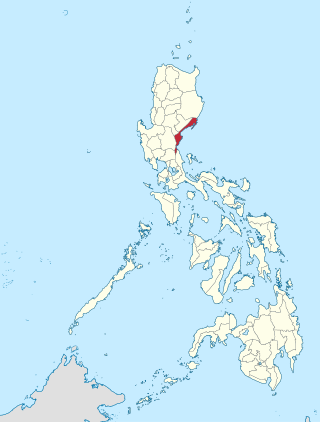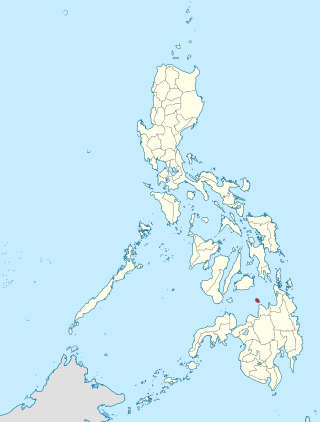
The New Society Movement, formerly named the New Society Movement of United Nationalists, Liberals, et cetera, is a right-wing political party in the Philippines. It was first formed in 1978 as an umbrella coalition of parties supporting then-President Ferdinand E. Marcos for the Interim Batasang Pambansa and was his political vehicle during his 20-year regime. It was reorganized as a political party in 1986, and is the furthest to the right of the political spectrum among active parties after Marcos' ouster.

The 1981 Philippine presidential election and national referendum was held on June 16, 1981. President Ferdinand E. Marcos of the Kilusang Bagong Lipunan (KBL) defeated retired general and World War II veteran Alejo Santos of the Nacionalista Party in a landslide victory. Most opposition parties boycotted the election as a sign of protest over the 1978 election for the Interim Batasang Pambansa, which they condemned as fraudulent. At the same time, a national referendum was held on the question in holding elections for barangay elections in 1982.
The legislative districts of Agusan del Norte are the representations of the province of Agusan del Norte in the various national legislatures of the Philippines. The province is currently represented in the lower house of the Congress of the Philippines through its first and second congressional districts.
The legislative district of San Juan–Mandaluyong was the combined representation of the Metropolitan Manila municipalities of Mandaluyong and San Juan in the Regular Batasang Pambansa (1984–1986) and the lower house of the Congress of the Philippines (1987–1995).
The legislative districts of Aklan are the representations of the province of Aklan in the various national legislatures of the Philippines. The province is currently represented in the lower house of the Congress of the Philippines through its first and second congressional districts.
The legislative districts of Agusan del Sur are the representations of the province of Agusan del Sur in the various national legislatures of the Philippines. The province is currently represented in the lower house of the Congress of the Philippines through its first and second congressional districts.
The Interim Batasang Pambansa was the legislature of the Republic of the Philippines from its inauguration on June 12, 1978, to June 5, 1984. It served as a transitional legislative body mandated by the 1973 Constitution as the Philippines shifted from a presidential to a semi-presidential form of government.
The Legislative district of Las Piñas–Parañaque was the combined representation of the Metropolitan Manila municipalities of Las Piñas and Parañaque in the Regular Batasang Pambansa from 1984 to 1986.
The Legislative district of Taguig–Pateros–Muntinlupa was the combined representation of the Metropolitan Manila municipalities of Muntinlupa, Pateros and Taguig in the Regular Batasang Pambansa from 1984 to 1986.
The Legislative district of Malabon–Navotas–Valenzuela was the combined representation of the Metropolitan Manila municipalities of Malabon, Navotas and Valenzuela in the Regular Batasang Pambansa from 1984 to 1986.
The Legislative district of Pasig–Marikina was the combined representation of the Metropolitan Manila municipalities of Pasig and Marikina in the Regular Batasang Pambansa from 1984 to 1986.
A national plebscite and local plebiscites were held on April 7, 1981 in the Philippines. The plebiscite was set to amend the following revisions made by the Interim Batasang Pambansa, pursuant to Batasang Pambansa Blg. 122:
A national referendum-plebiscite was held on October 16–17, 1976 in the Philippines in which the majority of the barangay voters approved the continuation of Martial Law and ratified the proposed amendments to the Constitution substituting the Regular Batasang Pambansa with the Interim Batasang Pambansa, pursuant to Presidential Decrees Nos. 991, 1031, and 1032.
Southern Leyte's at-large congressional district refers to the lone congressional district of the Philippines in the province of Southern Leyte. It was represented in the House of Representatives of the Philippines 1961 until 2022. Southern Leyte first elected a single representative provincewide at-large representative for the 5th Congress of the Third Philippine Republic following its creation as a regular province separate from Leyte under Republic Act No. 2227 on May 22, 1959. Before 1959, its territory was represented as part of Leyte's at-large, 2nd and 3rd districts. Between 1978 and 1984, multi-seat regional delegations were formed in lieu of provinces for the Fourth Philippine Republic parliament known as the Interim Batasang Pambansa, with Southern Leyte forming part of the ten-seat Region VIII's at-large district. It was restored as a single-member district in 1984.

Pasay's at-large congressional district is the sole congressional district of the Philippines in the city of Pasay. It has been represented in the House of Representatives of the Philippines since 1987 and earlier in the Batasang Pambansa from 1984 to 1986. Pasay first elected a single representative city-wide at-large for the Regular Batasang Pambansa following the 1984 Philippine constitutional plebiscite that amended the 1973 constitution and abolished the regional at-large assembly districts. Before 1973, the city was represented in the national legislatures as part of Rizal's 1st and at-large districts and Manila's at-large district. The district was re-created on February 2, 1987 following the ratification of the 1987 constitution that restored the House of Representatives. It is currently represented in the 19th Congress by Antonino G. Calixto of the PDP–Laban.

Aurora's at-large congressional district is the sole congressional district of the Philippines in the province of Aurora. It has been represented in the House of Representatives since 1987 and earlier in the Batasang Pambansa from 1984 to 1986. Aurora first elected a single representative provincewide at-large for the Regular Batasang Pambansa following its creation as a regular province separate from Quezon in 1978 and the subsequent 1984 Philippine constitutional plebiscite that amended the 1973 constitution and abolished the regional at-large assembly districts. Before 1978, the province was represented in the national legislatures as part of Quezon's 1st congressional district. The district was re-created on February 2, 1987 following the ratification of the 1987 constitution that restored the House of Representatives. It is currently represented in the 18th Congress by Rommel T. Angara of the Laban ng Demokratikong Pilipino (LDP).
Zamboanga del Sur's at-large congressional district is an obsolete congressional district that encompassed the area of Zamboanga del Sur in the Philippines. It was represented in the House of Representatives from 1953 to 1972 and in the Regular Batasang Pambansa from 1984 to 1986. The province of Zamboanga del Sur was created as a result of the partition of Zamboanga in 1952 and elected its first representative provincewide at-large during the 1953 Philippine House of Representatives elections. Roseller T. Lim, who served as representative of Zamboanga's at-large congressional district during the partition, was this district's first representative. The district remained a single-member district until the dissolution of the lower house in 1972. It was later absorbed by the multi-member Region IX's at-large district for the national parliament in 1978. In 1984, provincial and city representations were restored and Zamboanga del Sur elected three members for the regular parliament with a separate representation created for Zamboanga City. The district was abolished following the 1987 reapportionment to establish three districts under a new constitution.
Zamboanga City's at-large congressional district is an obsolete congressional district that encompassed the entire Zamboanga City prior to its 2004 reapportionment that took effect in 2007. It existed from 1984 to 2007, when Zamboanga elected a representative city-wide at-large to the Batasang Pambansa and to the restored House of Representatives. Before 1984 when it was granted its own seat in the regular Batasan assembly as a highly-urbanized city, Zamboanga was represented as part of the multi-member Region IX's at-large assembly district for the Interim Batasang Pambansa and was also earlier included in Zamboanga del Sur's at-large congressional district for the Third Philippine Republic congresses. It was last represented by Erico Basilio Fabian of the Laban ng Demokratikong Pilipino (LDP).

Camiguin's at-large congressional district is the sole congressional district of the Philippines in the province of Camiguin. It was created ahead of the 1969 Philippine House of Representatives elections following the separation of the island from Misamis Oriental to form its own province in 1966. The district was represented in the final congress of the Third Philippine Republic from 1969 to 1972, in the regular parliament that replaced the House of Representatives from 1984 to 1986, and in the restored House from the 8th Congress onwards. It is currently represented in the 19th Congress by Jurdin Jesus Romualdo of Lakas–CMD.
Makati's at-large congressional district may refer to two occasions when a city-wide or provincewide at-large district was used for elections to the Regular Batasang Pambansa from Makati in the Philippines.





